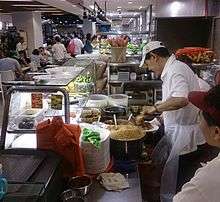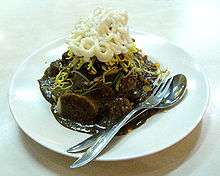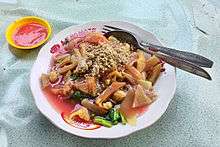Rojak
Rojak (Malay spelling) or Rujak (Indonesian spelling) is an Indonesian — Javanese traditional fruit and vegetable salad dish, commonly found in Indonesia, Malaysia and Singapore.[2][3] Other than referring to this fruit salad dish,[4] the term rojak also means "mixture" or "eclectic mix" in colloquial Malay.[5][6]
Fruit rujak in Indonesia, seasonal fruits with spicy palm sugar dressing, served in a stone mortar. | |
| Alternative names | Rujak |
|---|---|
| Type | Salad |
| Place of origin | Indonesia[1] |
| Region or state | Java, and Nationwide in Indonesia, also popular in Malaysia, Singapore and Sri Lanka |
| Associated national cuisine | Indonesia, Malaysia, Singapore |
| Serving temperature | Fresh in room temperature |
| Main ingredients | Fruits, vegetables, palm sugar, peanuts and chilli dressing. |
Rujak is available everywhere across Indonesia, and there are rich variations within the country. The most popular rujak variant is rujak buah (fruit rujak), which is mixed sliced fruit and vegetables served with a spicy palm sugar dressing.[7] Unlike common fruit salads, rujak is often described as tangy and spicy fruit salad due to its sweet, hot and spicy dressing made from ground chilli, palm sugar and peanuts.[8] It is a popular street fare in Bali.[9]
Indonesian rujak is usually made from fresh ingredients, especially fruits and vegetables. Rojak in Malaysia and Singapore has heavy Indian influence and contains fried tofu, hard-boiled eggs, shredded jícama and cucur udang (prawn fritters).[10] Rujak is usually a vegetarian dish which does not contain any animal products, except the sweet and tangy dressing which might contain prawn paste. Nevertheless, some recipes may contain seafood or meat. Rojak in Malaysia and Singapore usually contains sotong (cuttlefish), while certain rujak recipes in Indonesia may contain seafood or meat.
History and origin

The origin of rujak is unclear, and there are numbers of rujak variants in Southeast Asia, especially in Indonesia and Malaysia. It is possible that since ancient times, the natives of the Malay archipelago ate sour-tasting seasonal tropical fruits—especially Java apple, kedondong and unripe mango, together with palm sugar and salt to balance the sourness. In Indonesia, certain fruit trees have their own fruit-bearing seasons usually from late in the dry season to the wet season, thus the time of fruit harvest usually coincides with the time of having rujak in Indonesian villages. The fruit species seasonally anticipated for rujak feasts are mango, Java apple and kedondong.[11][12]
Rujak is one of the oldest dishes and the earliest historically identified food of ancient Java. It was mentioned as rurujak in ancient Javanese Taji inscription (901 CE) from the era of Mataram Kingdom in Central Java.[1] The Javanese in Indonesia have incorporated rujak into their prenatal ceremony called Naloni Mitoni.[13] According to local traditions, unripe mango and other sour-tasting fruits are craved by pregnant women, apparently as the counterpart of pickles in the West.[14]
The introduction of hot and spicy chilli pepper and peanuts may have taken place during the early colonial era in the 16th century, since these products were brought by Spanish and Portuguese traders from the Americas. It's suggested that rujak might be related to Indonesian gado-gado, while the rojak in Malaysia and Singapore demonstrate Indian influences with orange-coloured peanut and sweet potato sauce as a dip for fried fritters (with vegetables, coconut, prawn or other items inside), eggs and potatoes.[6]

In Indonesia, rujak is a traditional fare, sold in traditional marketplaces, warungs or travelling gerobak pushcart by locals; especially Javanese, Sundanese and Balinese people.[14] In Malaysia, rojak is associated with Mamak stalls, which are Muslim Malaysian Indian food stalls where rojak mamak is a popular dish.[15] In Singapore, rojak mamak is mainly sold by Indian Muslims, rojak buah (fruit rojak) mainly by the Chinese, and rojak Bandung (Cuttlefish) mainly by the Malays. Today, they are sold in most hawker centres in the city.[6]
Cultural significance

In Indonesia, among the Javanese, rujak is an essential part of the traditional prenatal ceremony called tujuh bulanan (literally: seventh month). The ritual was meant to wish the mother-to-be a safe, smooth and successful labour.[13] Special fruit rujak is made for this occasion, and later served to the mother-to-be and her guests, primarily her female friends. It is widely known that the sweet, spicy and sour tastes of rojak are adored by pregnant women. The recipe of rujak for this ceremony is similar to typical Indonesian fruit rujak, with the exceptions that the fruits are roughly shredded instead of thinly sliced, and that jeruk bali (pomelo/pink grapefruit) is an essential ingredient. It is believed that if the rujak overall tastes sweet, the unborn would be a girl, and if it is spicy, the unborn baby is a boy.[16]
Mangarabar, or rujak making, is a special event for the inhabitants of the Batak Mandailing region in Tapanuli, North Sumatra, Indonesia after the harvest. Normally the whole village will be involved in making and consuming the rujak.[17]
In Malaysia and Singapore, the term "rojak" is also used as a colloquial expression for an eclectic mix, in particular as a word describing the multi-ethnic character of Malaysian and Singaporean society.[18][5][6]
Indonesian rujak

Rujak Buah (Indonesian fruit rujak)

Rujak buah is Indonesian fruit rujak, also known as rujak manis (sweet rujak). The typical Indonesian fruit rujak consists of slices of assorted tropical fruits such as jambu air (water apple), pineapple, unripe mangoes, bengkoang (jicama), cucumber, kedondong and raw red ubi jalar (sweet potato). Sometimes Malang variants of green apple, belimbing (starfruit) and jeruk Bali (pomelo) are added. The sweet and spicy-hot bumbu rujak dressing is made of water, gula jawa (palm sugar), asem jawa (tamarind), crushed peanuts, terasi (prawn paste), salt, bird's eye chilli and red chilli. All of the fruits are cut to bite-size pieces, and put in the dish.[19]
The bumbu rujak or thick sweet spicy rujak dressing is poured on the fruit slices. An addition of sambal garam powder (a simple mixture of salt and ground red chilli) is put on side as the alternative for those who prefer a salty taste for their rujak. The Javanese people call this kind of rujak as lotis.[20]
Rujak Cuka
Rujak cuka literally means "vinegar rujak". It is a speciality of Sundanese cuisine of West Java, noted for its sour freshness. It is made of shredded fruits such as pineapple and unripe mango, and vegetables such as jícama, cabbage, bean sprouts and cucumber. It is quite similar to asinan due to its sour and spicy dressing, since both dishes contain vinegar, palm sugar and chilli.[21]
Rujak Tumbuk (Rujak Bēbēk)
This is another variant of Indonesian fruit rujak. The ingredients are almost the same as typical Indonesian fruit rujak, with the exception that all the ingredients are being ground or mashed together (tumbuk or bēbēk in Indonesian) in a wooden mortar. The fruits being ground are young/green pisang batu (a species of banana), raw red yam, jicama, Java apple, kedondong and young unripe mango. The dressing is not poured on the fruit, but already mixed together with all the ingredients. The dressing contains terasi prawn paste, palm sugar, salt and birds-eye chilli. Traditionally, rujak tumbuk is served in individual smaller portions on banana leaf plates called pincuk, however today it is commonly served in plastic cups.
Rujak Serut
This literally means "shredded rujak", and is another variant of Indonesian fruit rujak. As with rujak tumbuk, the ingredients are similar to Indonesian fruit rujak, with the exceptions that the fruits are not cut into bite-sized pieces, but shredded into a roughly grated consistency.
Rujak u' Groeh
A delicacy from Aceh province, this rujak consists of very young and tender coconut meat, young (green) papaya, bird's eye chilli, sugar, palm sugar, ice, salt and a dash of lime. This rujak is best eaten cold.[22]
Rujak Pengantin
"Pengantin" means "bride-and-groom pair" in Indonesian. This rujak is reminiscent of Indonesia's colonial cuisine. It contains slices of boiled eggs, potatoes, fried tofu, pineapple, carrot, bean sprouts, pickles, chilli, lettuce, cabbage, cucumber, emping crackers, roasted peanuts, peanut sauce and little vinegar. In some variants, the peanut sauce is mixed with mayonnaise. It is somewhat like Central Javanese gado-gado.
Rujak Kuah Pindang

A Balinese snack, a variation of the Indonesian fruit rujak, but instead of the normal rujak dressing, the fruits are soaked in a spiced fish broth. The broth consists of terasi (fermented prawn paste), salt, bird's eye chilli, red chilli and fish broth.[23]
Rujak Cingur

Cingur (pronounced "ching-ur") literally means "mouth" in Javanese. This variant of rujak originates from Surabaya. This speciality rujak from East Java has a "meaty" taste. It contains slices of cooked buffalo or cow lips, bangkuang, unripe mango, pineapple, cucumber, kangkung, lontong (rice cake), tofu and tempe, all served in a black sauce made from petis (black fermented prawn paste, related to terasi) and crushed peanuts. It is topped with a sprinkle of fried shallots and kerupuk (Indonesian prawn crackers).[24]
Rujak Petis
This is another variant of rujak from Surabaya. It contains slices of bangkuang, unripe mango, cucumber, kangkung (water spinach), kedondong, tofu and soybean sprouts all served in a black sauce made from petis (sticky black fermented prawn paste, related to terasi), fried shallots, salt, palm sugar, unripe banana and crushed peanuts. Traditionally it is served on a banana leaf; today it is more commonly served on plates.
Rujak Tolet
Similar to fruit rujak, and also from Surabaya. Aside from unripe fruits the rojak also includes fried tofu, fried garlic and optionally beef tendons. The sauce is petis-based mixed with palm sugar, slices of raw bird's eye chilli and sweet soy sauce.
Rujak Juhi
Juhi means salted cuttlefish in Indonesian; this rujak contains fried tau kwa tofu, fried boiled potatoes, fried shredded salted cuttlefish, cucumber, noodles, lettuce, cabbages, peanut sauce, vinegar, chilli and fried garlic. This dish was originated from the Chinese community in Batavia (now Jakarta) and now has become a Betawi dish closely related with Asinan Betawi.[25]
Rujak Shanghai

Named after "Bioscoop Shanghay" (a cinema named after Shanghai, China's most populated city) In Batavia Kota area, this dish was created by Indonesia's Chinese community. This variant of rujak can be found in Indonesian Chinatowns in cities such as Glodok in Jakarta. Rujak Shanghai contains seafood, like Rujak Juhi. Boiled sliced gurita (octopus) and edible jellyfish are served with kangkung, and served with thick red sweet and sour sauce, mixed with pineapple juice, and toasted crushed peanuts. Usually chilli sauce and pickled bengkoang are served as condiments.[26]
Rujak Soto
A delicacy from Banyuwangi, East Java, it is a unique blend between beef soto and rujak cingur. A local speciality in which the vegetables (water spinach and bean sprouts) rujak served with lontong rice cake in petis sauce poured with soto soup. It was created in 1975 by Usni Solihin.[27]
Malaysian and Singaporean rojak
Rojak Mamak

In Malaysia, mamak rojak (also known as Indian rojak or Pasembur) contains fried dough fritters, tofu, boiled potatoes, prawn fritters, hard boiled eggs, bean sprouts, cuttlefish and cucumber mixed with a sweet thick, spicy peanut sauce.[15] This type of rojak originated from Kedah where it was made by Malay villagers. After having learnt the recipe, Tamil Muslim (Mamak) rojak vendors used modified sidecar motorcycles as preparation counters and to peddle their rojak. Later, it became popularly known as Rojak Mamak. These mobile vendors now use modified mini trucks. The Pasembur available in Singapore is an assortment of potatoes, hard-boiled eggs, tofu and prawn fritters, and served with a sweet spicy chilli sauce. In the northwestern region of Peninsular Malaysia (Penang, Kedah, Perlis, Perak), it is always called pasembur, while in Kuala Lumpur and Singapore it is called rojak.
Rojak Buah (fruit rojak)

Sold by the Chinese, the Chinese fruit rojak typically consists of cucumber, pineapple, jícama, bean sprouts, taupok (puffy, deep-fried tofu) and youtiao (cut-up Chinese-style fritters). Unripe mangoes and green apples are less commonly used. The dressing is made of water, belacan, sugar, chilli and lime juice. Ingredients vary among vendors, with some adding prawn paste (hae ko in Hokkien), tamarind or black bean paste to the mix. The ingredients are cut into bite-sized portions and tossed in a bowl with the dressing, and topped with crushed peanuts and a dash of ground or sliced torch ginger bud (bunga kantan in Malay).
Rojak Penang is another type of rojak found in Penang, Malaysia. It is similar to fruit rojak with the addition of jambu air, guava, squid fritters and honey to the mixture, emphasis on the use of tart fruits such as unripe mangoes and green apples, and usually omits the bean sprouts and fried tofu puffs. The sauce or dressing for the rojak tends to be very thick, with an almost toffee-like consistency.
Rojak Bandung or Sotong Kangkung
Singaporean Malays have a distinct rojak known as rojak Bandung or sotong kangkung in other cities. It has become so famous in Malaysia, that it can be found at most rojak stalls. Sotong kangkung contains sotong (cuttlefish), kangkung, cucumber, tofu, peanuts, chilli and sauce.
See also
- Asinan – A pickled vegetable or fruit dish from Indonesia
- Gado-gado
- List of fruit dishes – Wikipedia list article
- List of salads – Wikipedia list article
- Mamak stall
- Pasembur
- Pecel – Indonesian dish
- Bahasa Rojak

References
- "Menguak Fakta Menu Lalapan Sunda Lewat Prasasti Taji". beritasatu.com (in Indonesian). Retrieved 23 December 2017.
- "Rujak Indonesian Fruit Salad & Tangy Peanut Citrus Sauce". Food.com.
- Indonesia OK!!: The Guide with a Gentle Twist. Galangpress Group. 2004. p. 80. ISBN 9789799341792.
- "Rujak". KBBI.
- "Rojak". Glosbe.
- "Rojak". Your Singapore.
- Dina Yuen (2012). Indonesian Cooking: Satays, Sambals and More. Tuttle Publishing. ISBN 9781462908530.
- "Spicy fruit salad (rujak)". SBS.
- Eka Juni Artawan (24 March 2016). "Savor: Rujak Bali – Spicy Balinese fruit salad". The Jakarta Post.
- "Malaysian Indian Mamak Style Rojak". 7 July 2016.
- "Infographics: Indonesia Fruit Season". Behance.
- Sigit Purwadi (17 August 2016). "Mengetahui Jadwal Musim Buah di Indonesia, Fruit is Nature's Candy" (in Indonesian).
- Lusiana Mustinda (26 November 2014). "Mitoni, Ritual Tujuh Bulanan untuk Kelancaran Persalinan". Food Detik.com (in Indonesian).
- Margaret Eiseman; Fred B. Eiseman (2012). Fruits of Bali. Tuttle Publishing. ISBN 9781462908790.
- "Top 10 Most Ordered Mamak Foods in Malaysia". Explorer Malaysia.
- Ana Amalia (26 July 2016). "Resep Rujak Serut Khas 7 Bulanan". Merah Putih (in Indonesian).
- Odilia Winneke Setiawati (22 August 2016). "Cara Tradisional Menikmati Kesegaran Buah Semusim". Detik Food (in Indonesian).
- Choo Woon Lim (1 April 2015). "'Rojak buah' a perennial favourite that represents Malaysian society". The Star.
- Sofiah Budiastuti. "Indonesian Fruit Salad (Rujak Buah)". All Recipes.
- "Lotis". Cookpad.
- "Resep Rujak Cuka". Cookpad.
- Tresna Purnama Dewi (12 July 2012). "Rujak U' Groeh". Budaya Indonesia.
- "Bali: Warung Rujak Gelogor". Good Indonesian Food. 2 November 2015. Archived from the original on 11 February 2017. Retrieved 10 February 2017.
- Jessicha Valentina (21 January 2016). "Surabaya: Rujak Cingur Ahmad Jais". Good Indonesian Food. Archived from the original on 11 February 2017. Retrieved 10 February 2017.
- "Jakarta: Rujak Juhi Bapak Misbah". Good Indonesian Food. Archived from the original on 11 February 2017. Retrieved 10 February 2017.
- "Rujak ala Encim di Pancoran". Kompas.com (in Indonesian). 1 May 2009.
- "Resep Rujak Soto Banyuwangi". Tempo (in Indonesian). 11 November 2016.
External links
| Wikimedia Commons has media related to Rujak. |